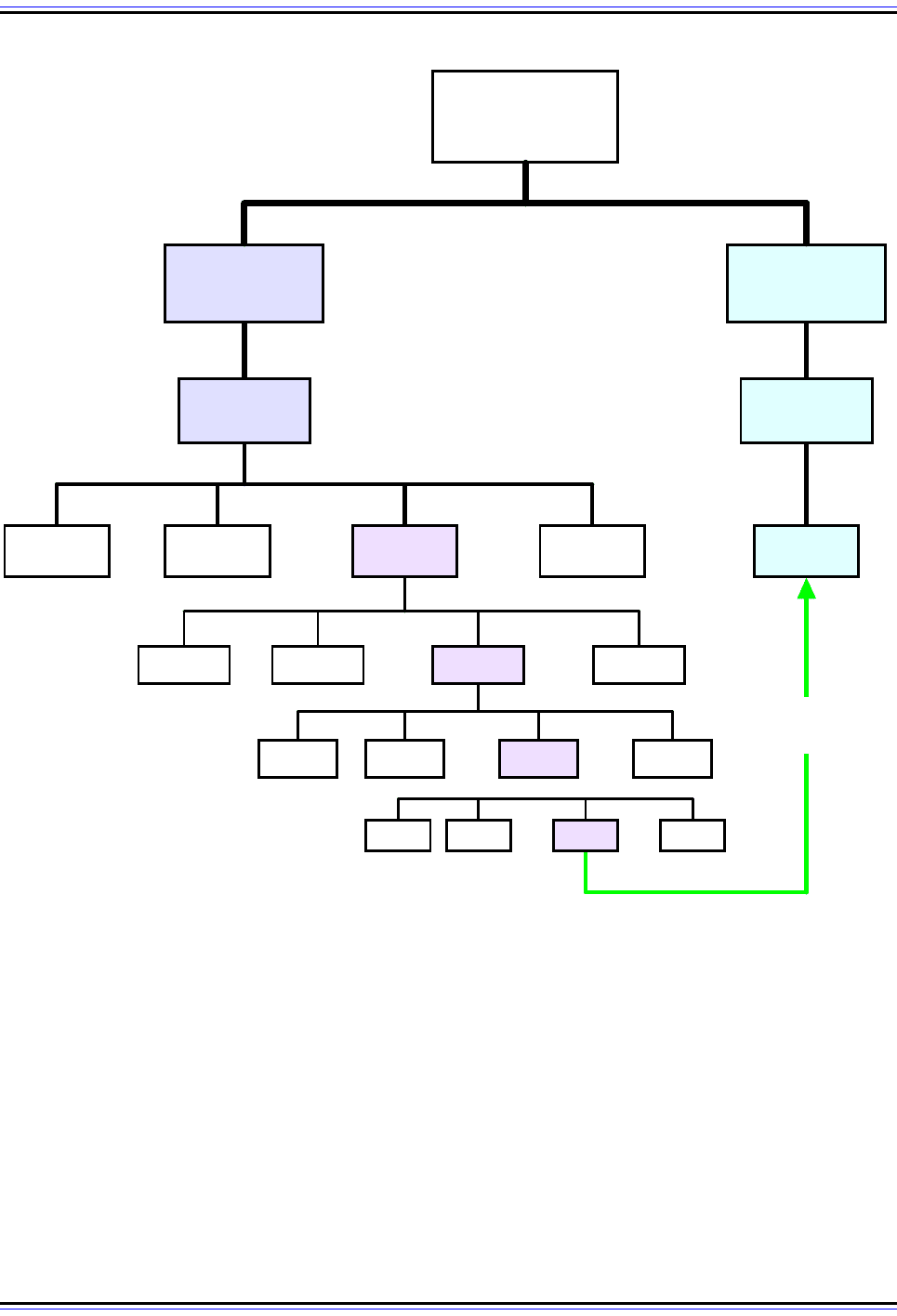Charles M. Kozierok The TCP-IP Guide
Подождите немного. Документ загружается.


The TCP/IP Guide - Version 3.0 (Contents) ` 1051 _ © 2001-2005 Charles M. Kozierok. All Rights Reserved.
Figure 246: The DNS IN-ADDR.ARPA Reverse Name Resolution Hierarchy
The special “IN-ADDR.ARPA” hierarchy was created to allow easy reverse lookups of DNS names. “IN-
ADDR.ARPA” contains 256 subdomains numbered 0 to 255, each of which has 256 subdomains numbered 0
to 255, and so forth, down four levels. Thus, each IP address is represented in the hierarchy. In this diagram I
have shown as an example the DNS domain name “www.xyzindustries.com”. It would have a conventional
resource record pointing to its IP address, 191.27.203.8, as well as a reverse resolution record at
8.203.27.191.IN-ADDR.ARPA, pointing to the domain name “www.xyzindustries.com”.
Inverse Address Pointer for
www.xyzindustries.com
(191.27.203.8)
(root)
arpa
in-addr
0 1 255191
0 1 27 255
1 1 203 255
0 1 8 255
...
...
...
...
... ...
... ...
com
xyzindustries
www

The TCP/IP Guide - Version 3.0 (Contents) ` 1052 _ © 2001-2005 Charles M. Kozierok. All Rights Reserved.
Resource Record Setup for Reverse Resolution
With the IN-ADDR.ARPA structure in place, we can now associate one entry in this name
space with each entry in the “real” DNS name space. We do this using the “PTR” (pointer)
resource record type. For example, if “www.xyzindustries.com” has the IP address
191.27.203.8, then the DNS server for its zone will have an address resource record
indicating this. In master file text format, it will say something like this:
www.xyzindustries.com. A 191.27.203.8
However, there will also be the following entry for it within the IN-ADDR.ARPA domain:
8.203.27.191.IN-ADDR.ARPA PTR www.xyzindustries.com
(Remember that DNS names are case-insensitive, so the “IN-ADDR.ARPA” could also be
given as “in-addr.arpa”).
Once this is done, reverse name resolution can be easily performed by doing a name
resolution on “8.203.27.191.in-addr.arpa”. If we do this, a server for the “IN-ADDR.ARPA”
domain will return to us the name “www.xyzindustries.com”. This is also shown in Figure
246.
Why The IN-ADDR.ARPA Structure Is the Opposite of Normal IP Addresses
I'm sure you've noticed that the numbers are “backwards” in the IN-ADDR.ARPA domain.
We've already seen the reason for this: name resolution proceeds from the least-specific to
the most-specific element, going from right to left. In contrast, IP addresses have the least
specific octet on the left, and the most specific on the right. Thus, we reverse them to
maintain consistency with the DNS name space.
This immediately yields us one extra benefit. Just as we can delegate authority for portions
of the regular name space, for example, letting “XYZ Industries” be in charge of everything
in “xyzindustries.com”, we can also delegate authority for parts of the IN-ADDR.ARPA
name space. For example, since MIT owns all IP addresses with a first octet of 18—at least
I think they still do—it is possible that if MIT wanted to, they could control the “18.IN-
ADDR.ARPA” domain as well for reverse queries. This would not be possible without
reversing the octets as we have done.
Note that for this system to work reliably, it is essential that the data in the “regular” name
space and the reverse name space remain consistent. Whenever a new DNS name is
registered, an appropriate entry must be made within IN-ADDR.ARPA as well. Special
procedures have been put into place to allow these pointer entries to be created
automatically.

The TCP/IP Guide - Version 3.0 (Contents) ` 1053 _ © 2001-2005 Charles M. Kozierok. All Rights Reserved.
Related Information: A similar scheme using a different reverse domain is used
for DNS under IPv6.
Key Concept: Most name resolutions require that we transform a DNS domain
name into an IP address. However, there are cases where we want to perform a
reverse name resolution, by starting with an IP address and finding out what domain
name matches it. This is difficult to do using the conventional DNS distributed name
hierarchy, because there is no easy way to find the DNS server containing the entries for a
particular IP address using the regular DNS name hierarchy. To this end, a special
hierarchy called IN-ADDR.ARPA was set up for reverse name lookups. This hierarchy
contains four levels of numerical subdomains structured so that each IP address has its
own node. The node for an IP address contains an entry that points to the DNS domain
name associated with that address.
DNS Electronic Mail Support and Mail Exchange (MX) Resource Records
Most savvy users of the Internet know that the Domain Name System exists, and usually
associate it with the most common Internet applications. Of these applications, the “big
kahuna” is of course the World Wide Web. It's probably the case that the majority of DNS
name resolution requests are spawned as a result of Web server domain names being
typed into browsers billions of times a day, as well as requests for named pages generated
by both user mouse clicks and Web-based applications.
Of course, DNS is not tied specifically to any one application. We can specify names in any
place where an IP address would go. For example, you can use a DNS name instead of an
address for an FTP client, or even for a troubleshooting utility like traceroute or ping. The
resolver will in each case take care of translating the name for you.
There's one application that has always used DNS, but it's one that doesn't usually spring to
mind when you think about DNS: electronic mail. Electronic mail is in fact more reliant on
DNS than just about any other TCP/IP application. Consider that while you may sometimes
type in an IP address for a command like traceroute, or even type it into a browser, you
probably have never sent anyone mail by entering “joe@14.194.29.60” into your e-mail
client. At least I never have in over a dozen years being online. You instead type
“joe@xyzindustries.com”, and DNS takes care of figuring out where electronic mail for XYZ
Industries is to go.
Special Requirements for Electronic Mail Name Resolution
Name resolution for electronic mail addresses is different from other applications in DNS,
for three reasons that I describe in the overview topic on TCP/IP e-mail addressing and
address resolution. To summarize: first, we may not want electronic mail to go to the exact

The TCP/IP Guide - Version 3.0 (Contents) ` 1054 _ © 2001-2005 Charles M. Kozierok. All Rights Reserved.
machine specified by the address; second, we need to be able to change server names
without changing everyone's e-mail address; and third, we need to be able to support
multiple servers for handling mail.
For example, XYZ Industries might want to use a dedicated mail server called “mail.xyzin-
dustries.com” to handle incoming mail, but actually construct all of its e-mail addresses to
use “@xyzindustries.com”. This makes addresses shorter, and allows the server's name to
be changed without affecting user addresses. If the company wishes, it might decide to use
two servers, “mail1.xyzindustries.com” and “mail2.xyzindustries.com”, for redundancy, and
again have just “@xyzindustries.com” for addresses.
The Mail Exchange (MX) Record and Its Use
To allow the flexibility needed for these situations, a special DNS resource record type is
defined called a mail exchange (MX) record. Each MX record specifies a particular mail
server that is to be used to handle incoming e-mail for a particular domain. Once this record
is established, resolution of electronic mail messages is pretty much similar to how it works
for regular resolution. Suppose we want to send an e-mail to “joe@xyzindustries.com”. The
process, roughly, is as follows:
1. Our e-mail client invokes the resolver on our local machine to perform an e-mail
resolution on “xyzindustries.com”.
2. Our local resolver and local DNS server follow the process described in the topic on
DNS name resolution to find the authoritative server for “xyzindustries.com”, which is
“ns1.xyzindustries.com”.
3. “ns1.xyzindustries.com” finds the MX record for “xyzindustries.com” and replies back
indicating that “mail.xyzindustries.com” should be used for e-mail.
Of course, the e-mail client can't actually send anything to “mail.xyzindustries.com”; it
needs its IP address. So, it would then have to resolve that name. Of course, this resolution
request will likely end up right back at the same DNS name server that just handled the MX
request. To eliminate the inefficiency of two separate resolutions, the DNS name server can
combine the information. In our example above, “ns1.xyzindustries.com” will include the A
(Address) resource record for “mail.xyzindustries.com” in the Additional section of the DNS
message that it sends in step 3 above.
It is also possible to specify multiple MX records for a particular domain, each pointing to a
different mail server's name. This provides redundancy, so if there is a problem with one
mail server, another can pick up the slack. DNS allows each mail server to be specified with
a preference value, so you can clearly indicate which is the main mail server, which is the
first backup, the second backup, and so on. The DNS server will choose the mail server
with the lowest preference value first, then the next highest one, and so on.

The TCP/IP Guide - Version 3.0 (Contents) ` 1055 _ © 2001-2005 Charles M. Kozierok. All Rights Reserved.
Key Concept: Since electronic mail is sent using host names and not IP addresses,
DNS contains special provisions to support the transfer of e-mail between sites.
Special mail exchange (MX) DNS resource records are set up that contain the
names of mail servers that a domain wants to use for handling incoming e-mail. Before
sending e-mail to a site, a device performs a name resolution to get that site’s MX record,
so it knows where to send the message.
Obsolete Electronic Mail Resource Records
Note that RFC 1035 originally defined several other resource record types related to
electronic mail as well: the mailbox (MB), mail group (MG) and mail rename (MR) resource
records. These are called “experimental” in the standard. I think the experiment failed,
whatever it was, because I don't believe these are used today. There are also two even
older mail-related resource records, mail destination (MD) and mail forwarder (MF), which
must have been used at one time but were already obsolete at the time RFC 1035 itself was
written.

The TCP/IP Guide - Version 3.0 (Contents) ` 1056 _ © 2001-2005 Charles M. Kozierok. All Rights Reserved.
DNS Messaging and Message, Resource Record and Master File Formats
Networking is all about the communication of information between connected devices. In
the case of the Domain Name System, information about names and objects on the inter-
network is exchanged during each of the many types of operations DNS performs. This
involves sending messages between devices. Like most protocols, DNS uses its own set of
messages with distinct field formats, and follows a particular set of rules for generating them
and transporting them over the internetwork.
In this section I explain how messages are generated and sent in DNS, and also describe
the formats used for messages and resource records. I begin with an overview discussion
of DNS messages and how they are generated and transported. I provide an overview of
the general DNS message format, and the five sections it contains. I describe the notation
used for names and the special compression method that helps keep DNS messages down
in size. I then show the fields in the DNS message header and question section. I illustrate
the common field format used for all resource records, and the specific fields in the most
important record types. I conclude with a description of the format used for DNS text master
files.
DNS Message Generation and Transport
In the preceding sections we have explored the many different tasks that DNS servers and
resolvers perform: regular name resolution, reverse name resolution, e-mail resolution,
zone transfers, and more. Each of these operations requires that information be exchanged
between a pair of DNS devices. Like so many other TCP/IP protocols, DNS is designed to
accomplish this information transfer using a client/server model. All DNS exchanges begin
with a client sending a request, and a server responding back with an answer.
DNS Client/Server Messaging Overview
In the overview topic on TCP/IP's client/server nature, I explained a potential source of
confusion regarding these terms: the fact that they refer to hardware roles, software roles
and transactional roles. This issue definitely applies when it comes to DNS. We've already
seen that DNS implementation consists of two sets of software elements: resolvers that act
as clients and name servers that are of course the servers. Resolver software usually runs
on client machines like PCs, while name server software often runs on dedicated server
hardware.
However, these designations are based on the overall role of the hardware and software.
From a messaging viewpoint, the “client” is the initiator of the communication, regardless of
what type of machine does this initiating, and the “server” is the device that responds to the
client. A resolver usually acts as a client and a name server as a server. However, in a
particular exchange a DNS name server can in fact act as a client, in at least two cases.
First, in recursive name resolution, a server generates requests to others servers and
therefore acts as a client. Second, in administrative functions like zone transfers, one server
acts like a client and sends a request to another server. (There are no cases in DNS that I
know of where a resolver acts as a server, incidentally.)

The TCP/IP Guide - Version 3.0 (Contents) ` 1057 _ © 2001-2005 Charles M. Kozierok. All Rights Reserved.
Most transactions in DNS consist of the exchange of a single query message and a single
response message. The device acting as client for the transaction creates the query and
sends it to the server; the server then sends back a reply. This is done through the process
described in the next topic. In certain cases where a great deal of data needs to be sent,
such as zone transfers, the server may send back multiple messages. Multiple such trans-
actions may be required to perform a complete name resolution, as my example of the DNS
resolution process demonstrated.
DNS Message Transport Using UDP and TCP
TCP/IP of course has two different protocols for data transfer: the User Datagram Protocol
(UDP) and Transmission Control Protocol (TCP). UDP and TCP “share” level 4 in TCP/IP
because they are so different in terms of capabilities and operation. Some application
protocols need the services of TCP and can use it to take advantage of them, while others
are better off with the simpler UDP. DNS is itself a perfect example of the valid reasons for
having both UDP and TCP in the protocol suite, because it uses both.
UDP Message Transport
UDP is a simple connectionless protocol that provides no real features but is very fast. It is
ideally suited for small, quick exchanges of information, and can be faster than TCP
because there is no need to establish a connection. This makes it a good choice for most of
the conventional queries used in DNS, because they are normally very short, and fast data
exchange is important. For this reason, the DNS standards recommend use of UDP for
queries and replies as part of regular and reverse name resolution. UDP DNS messages
are limited to 512 bytes; longer messages are truncated and a special bit in the header is
set to indicate that this has occurred. If a message being truncated causes a problem for its
recipient, the query must be repeated using TCP, as described below.
Note: The 512 byte limit on DNS UDP messages can be surpassed if the optional
Extension Mechanisms for DNS (EDNS0) are implemented. These are described
in RFC 2671.
TCP Message Transport
Since UDP does not provide reliable delivery of messages, DNS clients must keep track of
requests they have sent. If no response is received after a particular amount of time, the
request must be retransmitted. The need to take care of these details is considered an
acceptable trade-off for the lower setup costs involved with UDP, such as not requiring a
connection. The rate at which retransmissions is sent is usually set at a minimum of 2 to 5
seconds to prevent excessive DNS traffic on the internetwork.
For certain special DNS transactions, UDP is simply inappropriate. The most common
example of such a transaction is a zone transfer. While the query for a zone transfer is small
in size, the amount of data sent in response can be quite large. The limit of 512 bytes for
UDP is not even close to enough. Furthermore, we really do need to make sure that a zone

The TCP/IP Guide - Version 3.0 (Contents) ` 1058 _ © 2001-2005 Charles M. Kozierok. All Rights Reserved.
transfer is accomplished reliably and with flow control and other data transfer management
features, or we risk having corrupted zone information in our secondary DNS server
databases.
The solution is to use TCP for these types of exchanges. TCP allows messages to be of
arbitrary length, and as a connection-oriented, acknowledged, reliable protocol, automati-
cally provides the mechanisms we need to ensure that zone transfers and other lengthy
operations complete successfully. The cost is the small amount of overhead needed to
establish the connection, but since zone transfers are infrequent (compared to the sheer
volume of regular name resolutions) this is not a problem.
You can see how DNS nicely illustrates the roles of both TCP and UDP in TCP/IP. Since
both transport protocols can be used, name servers listen for both UDP and TCP requests
on the same well-known port number, 53. The device acting as the client uses an
ephemeral port number for the transaction. All DNS messages are sent unicast from one
device directly to another.
Key Concept: DNS uses both UDP and TCP to send messages. Conventional
message exchanges are “short and sweet” and thus well-suited to the use of the very
fast UDP; DNS itself handles the detection and retransmission of lost requests. For
larger or more important exchanges of information, especially zone transfers, TCP is
used—both for its reliability and its ability to handle messages of any size.
DNS Message Processing and General Message Format
The previous topic discussed DNS message exchanges and the fact that they are all based
on the principle of client/server computing. In a particular exchange, one device acts as a
client, initiating the communication by sending a query; the other acts as the server by
responding to the query with an answer. This “query/response” behavior is an integral part
of DNS, and is reflected in the format used for DNS messages.
A common message format is used for DNS queries and responses. This message format
contains five sections that provide a place for the query asked by the client; the answer(s)
provided by the server; and header information that controls the entire process. Table 169
describes the DNS general message format, providing a brief summary of each of its
sections and how they are used. You can also see a simplified illustration of the message
format in Figure 247.
Table 169: DNS General Message Format (Page 1 of 2)
Section Name Description
Header
Contains fields that describe the type of message and provide important infor-
mation about it. Also contains fields that indicate the number of entries in the other
sections of the message.
Question
Carries one or more “questions”, that is, queries for information being sent to a
DNS name server.

The TCP/IP Guide - Version 3.0 (Contents) ` 1059 _ © 2001-2005 Charles M. Kozierok. All Rights Reserved.
Header and Question Section
The Header is always present in all messages and is fixed in length. In addition to
containing important DNS control information, it has a flag (QR) that indicates whether a
message is a query or a response. It also has four “count” fields that tell the recipient the
number of entries in the other four sections.
Answer
Carries one or more resource records that answer the question(s) indicated in the
Question section above.
Authority
Contains one or more resource records that point to authoritative name servers that
can be used to continue the resolution process.
Additional
Conveys one or more resource records that contain additional information related
to the query that is not strictly necessary to answer the queries (questions) in the
message.
Figure 247: DNS General Message Format
Table 169: DNS General Message Format (Page 2 of 2)
Section Name Description
Header
(12 bytes)
Question
(variable)
Answer
(variable)
Authority
(variable)
Additional
(variable)

The TCP/IP Guide - Version 3.0 (Contents) ` 1060 _ © 2001-2005 Charles M. Kozierok. All Rights Reserved.
When a client initiates a query, it creates a message with the fields in the Header filled in,
and one or more queries (requests for information) in the Question section. It sets the QR
flag to 0 to indicate that this is a query, and places a number in the QDCount field of the
header that indicates the number of questions in the Question section. The number of
entries in the others sections are usually zero, so their “count” fields (ANCount, NSCount
and ARCount) are set to 0 in the header. (While more than one question can be put into a
query, usually only one is included.)
When the server receives the query it processes it and performs the information retrieval
operation requested (if it can). It then uses the query as the basis for its response message.
The Header and Question sections are copied to the response message, and the QR flag is
set to 1 to indicate that the message is a reply. Certain fields are also changed in the header
to provide information back to the client. For example, the server sets the RCode
(Response Code) field to indicate whether the query was successful or if an error occurred,
and if one did occur, to indicate what the problem was. The next topic shows all the Header
fields and indicates how each is used by both client and server.
Resource Record Sections: Answer, Authority and Additional
The server is also responsible for filling in the other three sections of the message: Answer,
Authority and Additional. These sections share the same basic format, each carrying one or
more resource records that use a common record format. The number of records in each
section is indicated using the “count” fields in the message header. The sections differ only
in terms of the types of records they carry. Answer records are directly related to the
question asked, while Authority records carry resource records that identify other name
servers. Authority records are thus the means by which name servers are hierarchically
“linked” when the server doesn't have the information the client requested.
The Additional section exists for the specific purpose of improving DNS efficiency. There
are cases where a server supplies an answer to a query that it has reason to believe will
lead to a subsequent question that the server can also answer. For example, suppose a
server provides the name of another name server in the Authority section (an NS resource
record). The client may not have the address for that server, which would mean it has to
perform an extra name resolution to contact the referenced server. If the server providing
the NS record already knows the IP address for this name server, it can include it in the
Additional section. The same goes for a server providing an MX record as I explained in the
topic on DNS mail support.
Key Concept: DNS uses a general message format for all messages. It consists of a
fixed 12-byte Header, a Question section that contains a query, and then three
additional sections that can carry resource records of different types. The Answer
section usually contains records that directly answer the Question of the message; the
Authority section holds the names of name servers being sent back to the client, and the
Additional section holds extra information that may be of value to the client, such as the IP
address of a name server mentioned in the Authority section.
